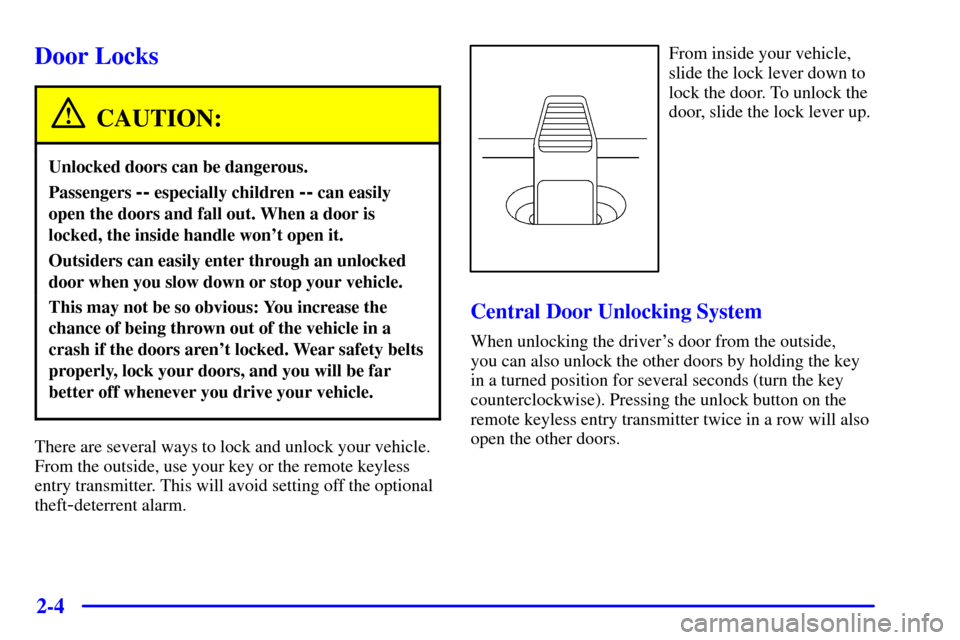Page 4 of 321
ii
Table of Contents
Keys and Door Locks
Remote Keyless Entry (RKE) System
Trunk Release
Automatic Transmission
Windows
Tilt Wheel
Turn Signal/Multifunction Lever
Windshield Wipers
Cruise ControlInterior and Exterior Lamps
Mirrors
Storage Compartments
Convenience Net
Accessory Power Outlet
OnStar® System (If Equipped)
Sunroof (Option)
HomeLink® Transmitter (Option)
Instrument Panel, Warning Lights and Gages Seats and Seat Controls
Safety BeltsAir Bag Systems
Child Restraints
Section
1
Section
2
Seats and Restraint Systems
Features and Controls
Page 21 of 321
1-9
Folding the Rear Seat
With the rear folding seatbacks, you can carry long cargo
by folding down part or all of the rear seat. Before you can
fold the rear seat, you need to unlatch the center buckle.
Insert a key or a similar
object into the slot as
shown to unlatch the
buckle. Move the belt
to the side so it is not
in your way.
To unlock the rear seatback, press the pushbutton at the
top of the seat and fold the seatback forward. To return
the seat to the passenger position, lift up on the seatback
and push it rearward until it latches. After returning the
seat to the passenger position, pull forward on the
seatback to make sure it is locked into place.
Page 37 of 321

1-25
The best way to protect the fetus is to protect the
mother. When a safety belt is worn properly, it's more
likely that the fetus won't be hurt in a crash. For
pregnant women, as for anyone, the key to making
safety belts effective is wearing them properly.
Right Front Passenger Position
To learn how to wear the right front passenger's safety belt
properly, see ªDriver Positionº earlier in this section.
The right front passenger's safety belt works the same
way as the driver's safety belt
-- except for one thing.
If you ever pull the shoulder portion of the belt out
all the way, you will engage the child restraint locking
feature. If this happens, just let the belt go back all the
way and start again.
Air Bag Systems
This part explains the frontal and side impact air
bag systems.
Your vehicle has air bags
-- a frontal air bag for the
driver and another frontal air bag for the right front
passenger. Your vehicle may also have side impact air
bags
-- a side impact air bag for the driver and another
side impact air bag for the right front passenger.
If your vehicle has
side impact air bags, it
will say AIRBAG on
the air bag covering
on the side of the
driver's and right front
passenger's seatback
closest to the door.
If Equipped
Frontal air bags are designed to help reduce the risk
of injury from the force of an inflating frontal air bag.
But these air bags must inflate very quickly to do their
job and comply with federal regulations.
Page 45 of 321

1-33 Servicing Your Air Bag-Equipped Vehicle
Air bags affect how your vehicle should be serviced.
There are parts of the air bag systems in several places
around your vehicle. Your dealer and the service manual
have information about servicing your vehicle and the
air bag systems. To purchase a service manual, see
ªService and Owner Publicationsº in the Index.
CAUTION:
For up to 10 seconds after the ignition key is
turned off and the battery is disconnected, an
air bag can still inflate during improper service.
You can be injured if you are close to an air bag
when it inflates. Avoid wires wrapped with
yellow felt, wires wrapped with yellow tape or
yellow connectors. They are probably part of
the air bag systems. Be sure to follow proper
service procedures, and make sure the person
performing work for you is qualified to do so.
The air bag systems do not need regular maintenance.
Safety Belt Pretensioners
Your vehicle has safety belt pretensioners. You'll find
them on the buckle end of the safety belts for the
driver and right front passenger. They help the safety
belts reduce a person's forward movement in a
moderate to severe crash in which the front of the
vehicle hits something.
Pretensioners work only once. If they activate in a crash,
you'll need to get new ones, and probably other new
parts for your safety belt system. See ªReplacing
Restraint System Parts After a Crashº in the Index.
Rear Seat Passengers
It's very important for rear seat passengers to buckle up!
Accident statistics show that unbelted people in the rear
seat are hurt more often in crashes than those who are
wearing safety belts.
Rear passengers who aren't safety belted can be thrown
out of the vehicle in a crash. And they can strike others
in the vehicle who are wearing safety belts.
Page 66 of 321

2-
2-1
Section 2 Features and Controls
Here you can learn about the many standard and optional features on your vehicle, and information on starting,
shifting and braking. Also explained are the instrument panel and the warning systems that tell you if everything is
working properly
-- and what to do if you have a problem.
2
- 2 Keys
2
- 4 Door Locks
2
- 7 Remote Keyless Entry System (RKE)
2
- 11 Trunk
2
- 12 Theft
2
- 13 Theft-Deterrent System (Option)
2
- 15 Immobilizer
2
- 16 New VehicleªBreak-Inº
2
- 16 Ignition Positions
2
- 18 Starting Your Engine
2
- 19 Engine Coolant Heater (If Equipped)
2
- 21 Automatic Transmission Operation
2
- 26 Parking Brake
2
- 27 Shifting Into PARK (P)
2
- 29 Shifting Out of PARK (P)
2
- 30 Parking Over Things that Burn2
- 31 Engine Exhaust
2
- 31 Running Your Engine While You're Parked
2
- 32 Windows
2
- 34 Horn
2
- 34 Tilt Wheel
2
- 35 Turn Signal/Multifunction Lever
2
- 41 Exterior Lamps
2
- 47 Interior Lamps
2
- 48 Mirrors
2
- 50 Storage Compartments
2
- 53 OnStar� System (If Equipped)
2
- 54 Sunroof (Option)
2
- 58 HomeLink� Transmitter (If Equipped)
2
- 62 The Instrument Panel -- Your
Information System
2
- 66 Warning Lights, Gages and Indicators
Page 67 of 321
2-2
Keys
CAUTION:
Leaving children in a vehicle with the ignition
key is dangerous for many reasons. A child or
others could be badly injured or even killed.
They could operate the power windows or
other controls or even make the vehicle move.
Don't leave the keys in a vehicle with children.
Page 68 of 321
2-3
One key is used for the
ignition, the doors and
all other locks. (Note that
there is no lock cylinder
for the trunk or the
passenger's door.)
Your vehicle comes with a spare key. This key does
not have an immobilizer pellet in it; however, it will still
unlock your vehicle's doors. Because of the key's flat
shape, it can be stored in your wallet.If you've lost your keys or need to have a new one
made, you will have to contact your dealer for the
correct key code.
NOTICE:
Your vehicle has a number of new features that
can help prevent theft. You can have a lot of
trouble getting into your vehicle if you ever lock
your keys inside and you may have to damage
your vehicle to get in. Be sure you have extra keys.
Page 69 of 321

2-4
Door Locks
CAUTION:
Unlocked doors can be dangerous.
Passengers -- especially children -- can easily
open the doors and fall out. When a door is
locked, the inside handle won't open it.
Outsiders can easily enter through an unlocked
door when you slow down or stop your vehicle.
This may not be so obvious: You increase the
chance of being thrown out of the vehicle in a
crash if the doors aren't locked. Wear safety belts
properly, lock your doors, and you will be far
better off whenever you drive your vehicle.
There are several ways to lock and unlock your vehicle.
From the outside, use your key or the remote keyless
entry transmitter. This will avoid setting off the optional
theft
-deterrent alarm.
From inside your vehicle,
slide the lock lever down to
lock the door. To unlock the
door, slide the lock lever up.
Central Door Unlocking System
When unlocking the driver's door from the outside,
you can also unlock the other doors by holding the key
in a turned position for several seconds (turn the key
counterclockwise). Pressing the unlock button on the
remote keyless entry transmitter twice in a row will also
open the other doors.